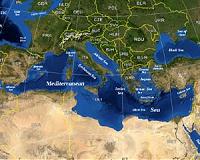| . |  |
. |
Ishinomaki, Japan (AFP) April 10, 2011 Prime Minister Naoto Kan pledged Sunday he would "never abandon" survivors of Japan's tsunami as he tried to focus attention on the future, despite a high-stakes battle at a nuclear plant. Kan, in only his second trip to the disaster zone in the month since the March 11 tragedy, was due to visit survivors to hear directly from victims to help shape policy in the weeks and months ahead, the government said. He will also call on all Japanese to keep spending, it was reported, as worries mount over the effect of the quake-tsunami on the world's third largest economy. But with high levels of radioactive caesium being found in fish caught off the coast of Fukushima, the situation at the nearby nuclear plant remains at the forefront of worries. Plant operator Tokyo Electric Power (TEPCO) is trying to halt the spread of radiation after having sealed a leak spewing highly contaminated water into the sea. Engineers over the weekend were installing a "silt curtain" around an intake pipe, intended to prevent radioactive mud from moving around the ocean, Kyodo reported, even as TEPCO continues to dump more than 10,000 tonnes of contaminated water in the sea. Kan was in Ishinomaki in worst-hit Miyagi prefecture on Sunday, to see first hand the devastation wreaked by the 9.0 magnitude quake and the massive tsunami it spawned. He told listeners to a radio station in the city: "The government will give all its strength to work with you. We will never abandon you." The premier was due at an emergency shelter later in the day, with chief government spokesman Yukio Edano telling reporters the visit was vital for the administration to understand the plight of those affected. "We believe it's important that we directly visit the areas and see for ourselves in a huge disaster like this," he said. "(Kan) will not be able to hear directly from all of the people affected by the disaster. But... it is meaningful that we receive direct input from the survivors about their conditions in order for us to decide policies and programmes for the future." He was also expected to urge Japanese to avoid "excessive self-restraint", Jiji Press reported, amid repeated calls for seasonal "hanami" -- alcohol-fuelled cherry blossom viewing -- parties to be toned down. The prime minister is worried that "stagnation in consumer spending caused by excessive self-restraint would be detrimental to the Japanese economy and reconstruction efforts in disaster-hit areas," Jiji reported, citing an unnamed official. But Japanese food's worldwide reputation for quality and safety took another hit with a report Sunday that a high level of caesium had been found in the sand lance, or konago, fish. Officials from Fukushima prefecture -- where the stricken nuclear plant is located -- found radiation measuring 570 becquerels per kilogram in a sample caught Thursday. The legal limit is 500. Previously, illegal levels of radioactive iodine had been found in the fish, but caesium has a much longer half-life. However, a voluntary halt to commercial fishing in the area means the fish would not have made it to market. Radiation has already been found in tap water and in farm produce from the region, leading to bans at home and abroad. On Saturday, Industry Minister Banri Kaieda donned full protective gear to become the first government member to step inside the nuclear plant, where workers are still battling with reactors at risk of overheating. TEPCO was planning Sunday to overfly the site with an unmanned helicopter to get a look at the state of the reactors, where workers are injecting inert nitrogen gas to head off a possible hydrogen explosion. Also Saturday, families in the resort city of Rikuzentakata became some of the first to move into temporary housing. Around 150,000 people remain in emergency centres, where residents complain of little privacy and spartan conditions, and even the basic prefabricated units are a welcome relief. Keiko Yoshioka, 35, was one of the lucky few chosen to move in to one of the 36 two-bedroom units on a school playing field in the city. "I feel a bit relieved that maybe now I can restart from scratch," she said. With so many still in shelters, ruling party lawmakers want an extra 500 billion yen ($5.9 billion) to construct a total of 70,000 units in tsunami-hit areas. Nearly 13,000 people are known to have died in the disaster, with another 15,000 still officially listed as missing. The government has said it thinks at least 82 children were orphaned, more than the 68 who lost both their parents in the 1995 Kobe earthquake, Japan's last major natural disaster, which claimed 6,400 lives.
Share This Article With Planet Earth
Related Links Bringing Order To A World Of Disasters When the Earth Quakes A world of storm and tempest
 Still no tsunami alert system in Med, experts deplore
Still no tsunami alert system in Med, experts deploreVienna (AFP) April 7, 2011 The Mediterranean still lacks a tsunami alert system, despite good intentions voiced after the Asian tsunami of 2004, scientists deplored Thursday in Vienna. "We have the experience and the tools to do this early warning (system), the structures are available," Joern Lauterjung, chairman of the German-Indonesian Tsunami Early Warning System (GITEWS) said on the sidelines of the European Geos ... read more |
|
| The content herein, unless otherwise known to be public domain, are Copyright 1995-2010 - SpaceDaily. AFP and UPI Wire Stories are copyright Agence France-Presse and United Press International. ESA Portal Reports are copyright European Space Agency. All NASA sourced material is public domain. Additional copyrights may apply in whole or part to other bona fide parties. Advertising does not imply endorsement,agreement or approval of any opinions, statements or information provided by SpaceDaily on any Web page published or hosted by SpaceDaily. Privacy Statement |